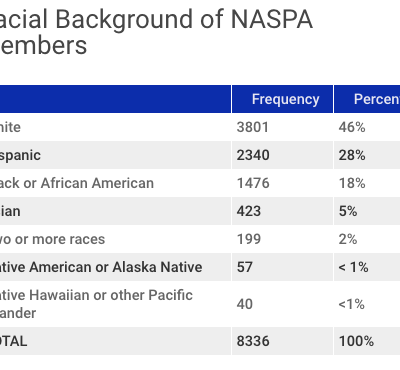Liliana Garces and Uma Jayakumar on a new model for understanding critical mass, promoting inclusive environments and facilitating the benefits of educational diversity on campus.
This is the latest post in a series sparked by recent student protests and the national dialogue on diversity and inclusion.
Over the past months, college students across the country have been demanding that their institutional leaders take action to address the persistence of racial bias, discrimination and negative campus climates that shape their learning environments. In short, students are seeking both diverse and inclusive campus environments. Students of color are demanding increased access, and just as important, campus communities that support them. These inclusive learning environments are necessary to realize the educational benefits of diversity, which extend to all students.
This concept of inclusivity is embedded in a body of educational research that has been in the works for over two decades. As contributors to this work, in 2014 we presented a new model for policy and practice called “dynamic diversity.” We conceived of this model to address the limitations of what we know in legal and education policy discussions as “critical mass,” or the need for institutions to have a meaningful number of students of color in order to promote the educational benefits of diversity, which includes breaking down racial stereotypes and avoiding the harms of tokenism and racial isolation.
While the concept of critical mass arguably has more of a contextual basis in some disciplines, the way it is used in legal and educational policy conversations is highly problematic because it pays little attention to the support mechanisms needed to allow for the full participation of all students and to help generate the benefits of diversity.
Dynamic diversity—a concept based on an analysis of decades of diversity- and inclusion-related research—promotes a more contextual understanding of critical mass as it focuses on the dynamic and symbiotic relationship between students and their environment. While the number of students of color can shape campus climate and culture, the campus climate and culture powerfully influences students’ experiences.
Put differently, while numbers are necessary for realizing the benefits of diversity, they are not alone sufficient. What we need moving forward is a shift in our understanding of diversity as solely a “numbers game” at the point of entry toward one that is more focused on creating the conditions for dynamic diversity.
Our analysis revealed four important areas that institutions can focus on to promote inclusive environments and advance the educational benefits of diversity:
Elements of Dynamic Diversity
Assess the racial climate
First, institutions need to consider the importance of a positive racial climate to instigate productive interactions.
Increasing the number of students of color on campus does not on its own result (directly) in students’ choosing to interact with people from different racial backgrounds. Rather, the data demonstrate that this desired type of interaction and the subsequent long-term benefits only happen when there is numeric diversity and a positive campus racial climate.
Given that learning from and through diversity requires interaction, specifically cross-racial interaction and participation, both an absence of students of color and a negative racial climate inhibit desired benefits. Institutions, therefore, should regularly assess campus racial climates to learn about and address the experiences of historically excluded students.
Attend to institutional history and context
Second, colleges and universities should attend to historical legacies of exclusion and other important signals they might be giving as to whether students are welcome on campus.
These signals include historical patterns regarding the entrance of students of color, specific state and institutional contexts, and policies that indicate whether students are welcome. Students’ educational experiences occur within a particular racial context determined by both socio-historical forces on campus and the larger policy context on both the state and federal level, which includes bans on race-conscious admissions policies.
These statewide policies, for example, can have negative consequences on the work of administrators, in part, by inhibiting conversations around race and racism and making them feel less empowered to advocate in support of racial diversity on campus. College and university leaders can respond with programming that supports the open discussion of race on campus and with equity-minded practices that shed light on how institutional policies and practices can have negative consequences for students of color.
Break down barriers to cross-racial engagement
Third, institutions can address impediments for productive interactions in learning environments, such as the harmful effects of racial isolation and stereotype threat, which undermine cross-racial interaction and classroom participation, and diminish the positive outcomes associated with diversity. These barriers to cross-racial engagement and participation and their subsequent detrimental impact on productive interactions are exacerbated at the classroom level and other constructed sub-environments of curricular and co-curricular learning on a campus.
Notably, racial isolation harms students of color and white students in distinctive ways. For students of color, racial isolation creates the feeling of racialized vulnerability, alienation and tokenization. For white students, racial isolation is harmful because it impairs their capacity to interact across race and to perceive racial bias and discrimination. Institutions can help break down these barriers by empowering campus administrators and faculty to more effectively facilitate interactions across race, and with the assistance of external intergroup relations experts, implement tools in their classrooms to help students understand different experiences of discrimination and privilege.
Nurture quality cross-racial interactions
Finally, institutions can nurture cross-racial interactions that contribute to learning and reduce prejudice.
In fact, failure to attend to the nature of cross-racial interactions and intergroup conditions, including any token inclusion of underrepresented groups, can increase racial tensions and the potential for negative cross-racial interactions. Such negative interactions are associated with unfavorable outcomes, such as reductions in civic engagement, self-confidence and moral reasoning skills. However, when the nature of cross-racial interaction allows for full participation, it triggers dynamic diversity by activating more lively discussion, challenging stereotypes, and promoting innovation and an expanded range of perspectives and solutions.
On this final point, it is important to consider that cross-racial interactions contribute to student learning and growth only insofar as these encounters challenge students’ preexisting stereotypes, beliefs and world views. Thus, attending to the nature—and quality—of cross-racial interactions is important and requires that groups are not lopsided in ways that promote stereotypes and racial isolation. These efforts require generating greater awareness among white students and predominantly white student organizations about systems of privilege. Such action can create a greater understanding about why programming that creates and supports “safe” spaces for students of color is necessary, and not counter-productive, for generating cross-racial interactions.
Measuring Whether an Institution Has Reached Dynamic Diversity
To determine whether dynamic diversity has been achieved, institutions can gather evidence through quantitative and qualitative measurement tools (e.g., online surveys, focus groups, interviews) of the campus racial climate, the experiences of students of color in classrooms and other campus environments, and the interactions among various racial and ethnic subgroups on campus. Institutions can further gauge their progress toward achieving these conditions for fostering dynamic diversity by periodically assessing the disparities in outcomes by race on important equity indicators such as retention rates.
The racial incidents taking place across college campuses around the country should be heard as sounding an alarm for much needed institutional change. It is time to refocus our attention on creating humanizing relationships between the educational environment and students—the interactions among students, the particular context in which these interactions take place, and the institutional conditions that are needed to generate the educational benefits of diversity for all. The quality of these contexts—involving but not limited to numbers—are exactly the conditions that give rise to dynamic diversity.
If you have any questions or comments about this blog post, please contact us.


